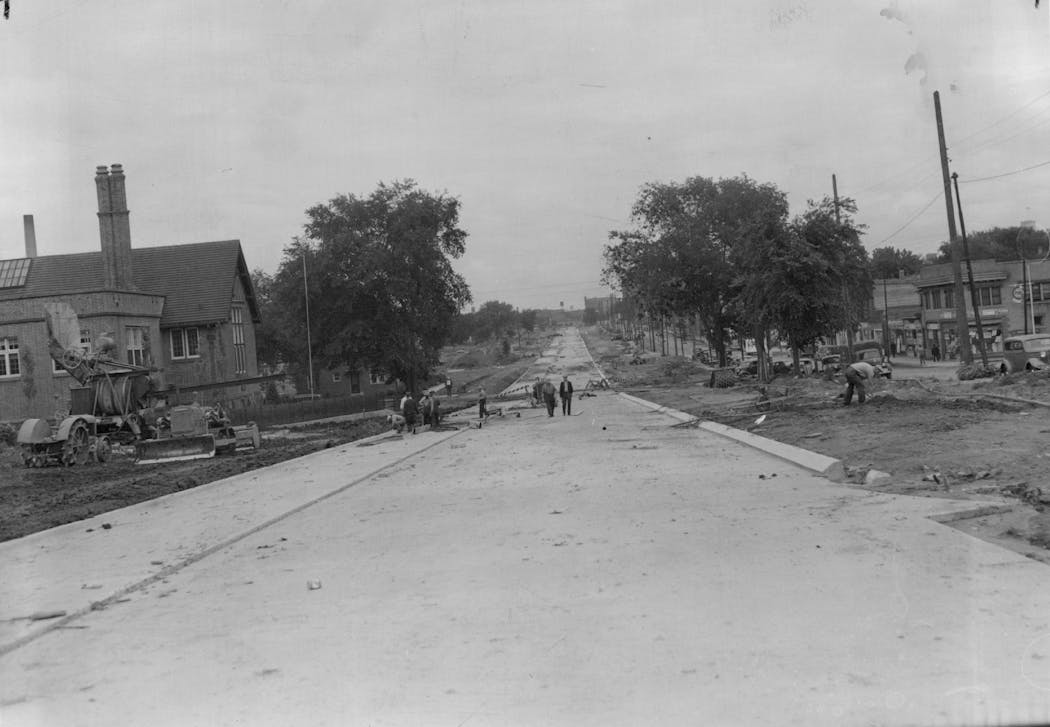The construction of Olson Highway through a stretch of north Minneapolis eradicated what was once a bustling commercial district for Black and Jewish residents.
Now, nearly a century later, a project aiming to convert a mile of the highway into a restored, more community-minded 6th Avenue N. is gaining momentum thanks to new federal funding.
The U.S. Department of Transportation recently granted $1.6 million to Our Streets Minneapolis, a nonprofit advocacy group spearheading the Bring Back 6th campaign in partnership with the Harrison Neighborhood Association. This funding is part of a $7 million grant allocated to locally led projects in Minnesota through the Reconnecting Communities Pilot program, a component of President Joe Biden's Investing in America Agenda. Minnesota Sens. Amy Klobuchar and Tina Smith announced the funding earlier this week.
"[The money] will allow us to work on this project for a couple of years continuously," said José Cabán, executive director of Our Streets Minneapolis.
Launched in 2021, the Bring Back 6th project seeks to transform the one-mile stretch of Olson Highway into a community corridor that reconnects the Near North neighborhood that was divided by the construction of the corridor. The goal, advocates said, is to create a healthier environment and opportunities for residents to access affordable housing, health care, employment, parks and other amenities.
Some residents of the area have concerns. Among them: gentrification, displacement and traffic delays. Cabán said traffic on Olson Highway has declined significantly in recent years as many drivers now use Interstates 394 and 94.
Cabán said his group would also like to see immediate near-term safety improvements in the area and a return of the land along the restored 6th Avenue N. corridor to the community.
Once known as the "Beale Street of Minneapolis," the Near North Side was a bustling commercial district predominantly occupied by the city's Black and Jewish communities.
In an effort to revitalize what was perceived as a "blighted" neighborhood, planners in the 1930s routed Olson Highway, a dedicated portion of Highway 55, through 6th Avenue N., "demolishing hundreds of homes, businesses and community institutions," according to advocates.
As part of the campaign, organizers worked with students from the University of Minnesota to research the neighborhood's lost history. They created a mobile history museum that has been showcased in various parts of Minneapolis, including Sumner Library, the only surviving building on 6th Avenue N.
North Side residents have long voiced safety concerns in their community, including issues with speeding and pollution.
From 2017 to 2021, traffic crashes killed or severely injured about 150 people each year in Minneapolis, according to city data.
As part of the city's goal to end traffic deaths and severe injuries, officials from Minneapolis' Vision Zero program interviewed North Side residents in the past, Cabán said, "but none of their concerns have been addressed."
The Minnesota Department of Transportation (MnDOT) made safety improvements in 2022 and 2023 to reduce the number and severity of crashes. The agency installed flexible posts, signage and marked pavement on Olson Highway designed to narrow the roadway, create shorter crossings for pedestrians and cyclists, and improve visibility for them and drivers.
Pollution is also an issue. North Minneapolis' 55411 ZIP code, which borders Olson Highway, is one of the poorest in Minneapolis and has the highest asthma hospitalization rate in the seven-county metro area, according to the city.
"MnDOT did install some improvements, but just not all of them," Cabán said. "This is a community that's been devastated, and their standard of living is low. Near-term improvements between now and the full reconstruction would allow people to engage with what's possible."
In 2023, the city passed a resolution in support of removing the North Side highway and restoring the area to a walkable neighborhood commercial street. Minneapolis officials also proposed new development along the corridor, including affordable and public housing, affordable commercial space, new parks and community gardens.
In early March, MnDOT unveiled four design alternatives for an improved roadway, including one that aligns with the vision of the Bring Back 6th campaign. The agency, which received the same federal funding for a larger study of Olson Highway, is conducting a corridor analysis to better understand the community's long-term needs and other safety and pedestrian improvements.
MnDOT officials said they will continue to engage the public in the planning and design process over the coming years; construction is expected to begin as early as 2028.
Our Streets Minneapolis members said they will generate their own report with the help of engineers and consultants, outlining alternative options for the highway, other than what MnDOT has presented.
Community members can share their feedback of MnDOT's design alternatives through an online survey or by attending its next community workshop from 4:30 to 6:30 p.m. Tuesday at Summit Academy OIC.

In Grand Rapids, Itasca Pride is planning its first event, but there is already pushback
One person shot at YMCA in Coon Rapids

BCA says man pointed pistol-style BB gun at officers before he was shot in Woodbury

Former diversity worker sues University of Minnesota after firing over swastika photo




